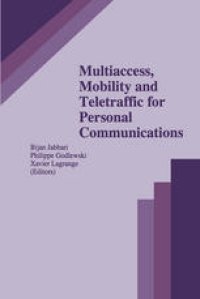
Ebook: Multiaccess, Mobility and Teletraffic for Personal Communications
Author: M. Andersin Z. Rosberg J. Zander (auth.) Bijan Jabbari Philippe Godlewski Xavier Lagrange (eds.)
- Tags: Electrical Engineering, Computer Communication Networks
- Series: The Kluwer International Series in Engineering and Computer Science 366
- Year: 1996
- Publisher: Springer US
- Edition: 1
- Language: English
- pdf
The success of first and second generation wireless systems has paved the way for further research opportunities towards the next generation systems. The two standards GSM and IS-95 based on TDMA and CDMA respectively, have deeply influenced our system-level understanding, bringing new perspectives on the problems associated with wireless networks and potential for innovations. This volume presents the proceedings of the second workshop on multiaccess, mobility and teletraffic for personal communications held in May 1996 in Paris, France where some important subjects on the next generation systems have been treated. These include topics dealing with information theoretic aspects, channel modeling, diversity, interference control, resource allocation, power control, packet multi-access, stochastic modeling of mobility and traffic, and wireless network control. The selected topics in this workshop and their presented set of solutions reflect the richness of the problems in wireless communications. Indeed, development of theoretical frameworks with considerable attention to the peculiar environment of wireless communications has been the prime objective of this workshop. To elaborate, consider the problem of multi-access methods which remains a challenge for researchers. A complete evaluation of an access scheme must consider different aspects such as propagation, interference, mobility and traffic modeling. Some common bases, paradigms and models are needed. For example, today, we do not have a common archetype like the A WGN channel as in classical statistical communication. Clearly, there is a need for justified assumptions and models.
The success of first and second generation wireless systems has paved the way for further research opportunities towards the next generation systems. The two standards GSM and IS-95 based on TDMA and CDMA respectively, have deeply influenced our system-level understanding, bringing new perspectives on the problems associated with wireless networks and potential for innovations.
This volume presents a collection of papers on multiaccess, mobility and teletraffic for personal communications treating many of the important subjects on the next generation systems. These include topics dealing with information theoretic aspects, channel modeling, diversity, interference control, resource allocation, power control, packet multi-access, stochastic modeling of mobility and traffic, and wireless network control.
Multiaccess, Mobility and Teletraffic for Personal Communications is an important book for researchers and students working in the area of Wireless Communication and Mobile Computing. It will be a valuable reference source and can be used as a secondary text for an advanced course on this subject.
The success of first and second generation wireless systems has paved the way for further research opportunities towards the next generation systems. The two standards GSM and IS-95 based on TDMA and CDMA respectively, have deeply influenced our system-level understanding, bringing new perspectives on the problems associated with wireless networks and potential for innovations.
This volume presents a collection of papers on multiaccess, mobility and teletraffic for personal communications treating many of the important subjects on the next generation systems. These include topics dealing with information theoretic aspects, channel modeling, diversity, interference control, resource allocation, power control, packet multi-access, stochastic modeling of mobility and traffic, and wireless network control.
Multiaccess, Mobility and Teletraffic for Personal Communications is an important book for researchers and students working in the area of Wireless Communication and Mobile Computing. It will be a valuable reference source and can be used as a secondary text for an advanced course on this subject.
Content:
Front Matter....Pages i-ix
Distributed Discrete Power Control in Cellular PCS....Pages 1-14
Congestion Measures and Capacity Constraints in Spread Spectrum Networks....Pages 15-28
Channel Control and Multiple-Access....Pages 29-42
On the Effect of Chip Synchronization Error in MC-CDMA Systems....Pages 43-56
Coded Modulations and Diversity for Satellite Cellular Communications....Pages 57-72
Multicode High-Speed Transmission with Interference Cancellation for Wireless Personal Communications....Pages 73-86
Packet Access for Cellular Systems: The Capacity of S-Aloha and CDPA with Slow Shadowing....Pages 87-102
Dynamic Slot Allocation for TDMA-Systems with Packet Access....Pages 103-116
Design and Evaluation of an RRA Scheme for Voice-Data Channel Access in Outdoor Microcellular Wireless Environments....Pages 117-130
Design and Evaluation of Paging Strategies for Personal Communications....Pages 131-144
Database Architectures and Location Strategies for Mobility Management in Mobile Radio Systems....Pages 145-156
Infinite Server Traffic Models for CDMA Cellular Mobile Networks....Pages 157-170
Modeling Priority Traffic and Hot Spots in Wireless PCS Systems....Pages 171-184
A Satellite-Augmented Cellular Network Concept....Pages 185-198
Recent Developments of Adaptive Air Interfaces....Pages 199-210
Feasibility Study for a GSM Private Cordless Base Station Based on Total Frequency Hopping....Pages 211-224
On Satellite Path Diversity for GSM Rate Compatible TDMA Big LEOs....Pages 225-240
An Optimal Channel Allocation Algorithm in a Linear Cellular Reuse Partitioning Network....Pages 241-248
Non-Coherent Diversity Receivers for Mobile and Personal Satellite Communications....Pages 249-263
....Pages 265-278